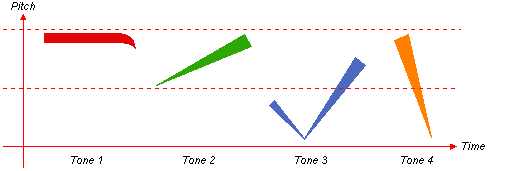Warning: file_put_contents(./cache/2.txt): failed to open stream: Permission denied in /data/clients/davidhoustin/chinese.gratis/www/method/index.php on line 275
The Chinese tones - Lesson 02

Introduction
Mandarin Chinese has 4 tones plus a neutral "tone". The tone used to pronounce the syllables of a Chinese word can completely change its meaning.
China has more than 80 different dialects. The 4 tones that you will learn here are those used for Mandarin, the official language. In Cantonese for example, there are 9 different tones! It may happen that the Chinese themselves make a mistake about the tone.
With pinyin, the tone of each syllable is indicated by the following marks:  or sometimes by the corresponding numbers 1,2,3 and 4 at the end of the syllables
or sometimes by the corresponding numbers 1,2,3 and 4 at the end of the syllables

1rst tone (阴平)
It is a high tone with a continuous sound like when the doctor asks you to say "haaaaaa". | 2d tone (阳平)
It is a rising tone, assuming an moderate level between low and high to finish in the highs. It is similar to the one used when seeking someone ("David?!"). |
3rd tone (上声)
It is a falling tone, going in the low and then rising in the highs. It can be easily pronounced by doubling the final of the syllable (eg "ma-a"). This tone is similar to that used when one is surprised ("What ?!"). | 4th tone (去声)
This tone is falling, high and short. It is similar to the intonation used for an authoritative exclamation ("No and no!"). |
Eg :
Sometimes called "5th tone" it is actually not really a tone but a "lighter" way to pronounce a syllable. Pronounce it the same way you would say a word in English without accent or intonation. |
With these different tones, tongue twisters are many in Chinese. For example, "mā mà mǎ ma?" (妈骂马吗?) means "Does mom insult the horse?".

Change of tone
The 3rd tone is sometimes difficult to use in a sentence. Thus, according to the tone of the syllable following this 3rd tone, it can change. There are 2 rules to remember:
- A 3rd tone placed before another 3rd tone turns into a 2d tone when speaking (and not in written)
- A 3rd tone before any other tone is subdued and does not go in the highs

Exercices
1/ Train yourself to pronounce the following words to get used to the tones:
2/ You can also use our "pinyin dictation" tool to train yourself to recognize more Chinese syllables.

The Chinese Characters











